

Mohenjo-daro. Location of Mohenjo-daro within the Pakistani province of Sindh.
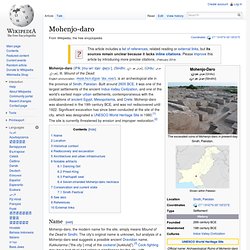
Mohenjo-daro (IPA: [muˑənⁱ dʑoˑ d̪əɽoˑ], (Sindhi: موئن جو دڙو), (Urdu: موئن جودڑو), lit. Mound of the Dead; English pronunciation: /moʊˌhɛn.dʒoʊ ˈdɑː.roʊ/), is an archeological site in the province of Sindh, Pakistan. Built around 2600 BCE, it was one of the largest settlements of the ancient Indus Valley Civilization, and one of the world's earliest major urban settlements, contemporaneous with the civilizations of ancient Egypt, Mesopotamia, and Crete. Mohenjo-daro was abandoned in the 19th century BCE, and was not rediscovered until 1922. Significant excavation has since been conducted at the site of the city, which was designated a UNESCO World Heritage Site in 1980.[1] The site is currently threatened by erosion and improper restoration.[2] Name[edit] Rudolf Steiner. Tesla - Master of Lightning. 20,000 Year-Old Aluminum ‘Vimana’ Aircraft Landing Gear Discovered. Terrence Aym beforeitsnews Some scholars are convinced an ancient, advanced civilization existed where the nation of India is today.
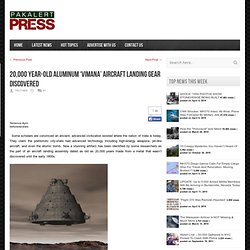
They claim the prehistoric city-state had advanced technology including high-energy weapons, jet-like aircraft, and even the atomic bomb. The UFO-shaped object found at the bottom of the Baltic Sea… covered in soot, with ‘little fireplaces’ and lying at the end of a 1,000ft runway. Object is raised about 10 to 13ft above seabed and curved at the sides like a mushroom It has a 60 metre diameter with an egg-shaped hole leading into it from the top Hole is surrounded by an strange rock formation that expedition team can not explain Stones are covered in something ‘resembling soot’ which has baffled experts Sceptics expected that a deep-water dive would debunk the slew of extra-terrestrial theories surrounding an unidentified object sitting at the bottom of the Baltic Sea.
But the Swedish expedition team that took the plunge surfaced with more questions than answers – and certainly no solution to its origins. Ancient Alien Moon ‘Fortress’ And Pyramids Revealed. When National Aeronautics and Space Administration Data and Photo Control Department manager, Ken Johnston, who worked for the space agency’s Lunar Receiving Laboratory during the Apollo missions, was fired for telling the truth about alien artifacts on the Moon, he went public. And the he blew the whistle on the American space agency. According to Johnston, Apollo astronauts brought back photographic evidence of the artifacts they found during their lunar extravehicular activities. Johnston claims NASA ordered him to destroy the EVA images while he was at the Jet Propulsion Laboratory, but he steadfastly refused.
Now stunning new photos have emerged that support the former NASA employee’s assertions — photos of pyramids — and one incredible photo that undeniably reveals a jaw-dropping alien lunar fortress… Alien Images Found In Ancient Stone Sphere. The stone spheres are silent, remaining mute through the ages. What secrets do they hold? Research into their origin has so far proved fruitless. A stone sphere like this one can weigh up to 16 tons. M. C. Escher. Maurits Cornelis Escher (/ˈɛʃər/, Dutch: [ˈmʌurɪts kɔrˈneːlɪs ˈɛʃər] ( );[1] 17 June 1898 – 27 March 1972), usually referred to as M.
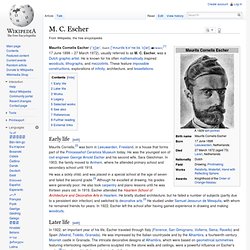
Still Life and Street. Still Life and Street is a woodcut print by the Dutch artist M.
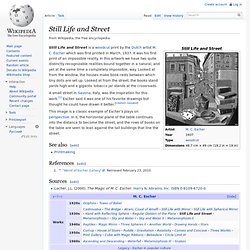
C. Escher which was first printed in March, 1937. It was his first print of an impossible reality. In this artwork we have two quite distinctly recognizable realities bound together in a natural, and yet at the same time a completely impossible, way. Tessellation. Ceramic Tiles in Marrakech, forming edge-to-edge, regular and other tessellations A periodic tiling has a repeating pattern.
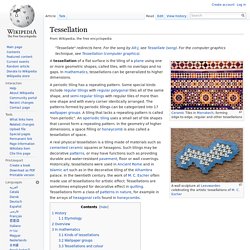
Some special kinds include regular tilings with regular polygonal tiles all of the same shape, and semi-regular tilings with regular tiles of more than one shape and with every corner identically arranged. The patterns formed by periodic tilings can be categorized into 17 wallpaper groups. A tiling that lacks a repeating pattern is called "non-periodic". An aperiodic tiling uses a small set of tile shapes that cannot form a repeating pattern. History[edit] A temple mosaic from the ancient Sumerian city of Uruk IV (3400–3100 BC) showing a tessellation pattern in the tile colours. Tessellations were used by the Sumerians (about 4000 BC) in building wall decorations formed by patterns of clay tiles.[1] Etymology[edit] Overview[edit] Many other types of tessellation are possible under different constraints. Other methods also exist for describing polygonal tilings. [edit] Mason. From Wikipedia, the free encyclopedia Mason may refer to: Occupations[edit]

Edward Leedskalnin. Edward Leedskalnin (Latvian: Edvards Liedskalniņš) (January 12, 1887, Stāmeriena parish, Livonia; December 7, 1951, Miami) was an eccentric Latvian emigrant to the United States and amateur sculptor who single-handedly built the monument known as Coral Castle in Florida.
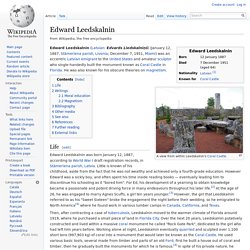
He was also known for his obscure theories on magnetism. Life[edit] Edward Leedskalnin was born January 12, 1887, according to World War I draft registration records, in Stāmeriena parish, Latvia. Little is known of his childhood, aside from the fact that he was not wealthy and achieved only a fourth-grade education. However Edward was a sickly boy, and often spent his time inside reading books — eventually leading him to discontinue his schooling as it "bored him". Then, after contracting a case of tuberculosis, Leedskalnin moved to the warmer climate of Florida around 1919, where he purchased a small piece of land in Florida City. Writings[edit] Moral education[edit] Some writers[who?] Magnetism[edit] Bibliography[edit] Scribd.